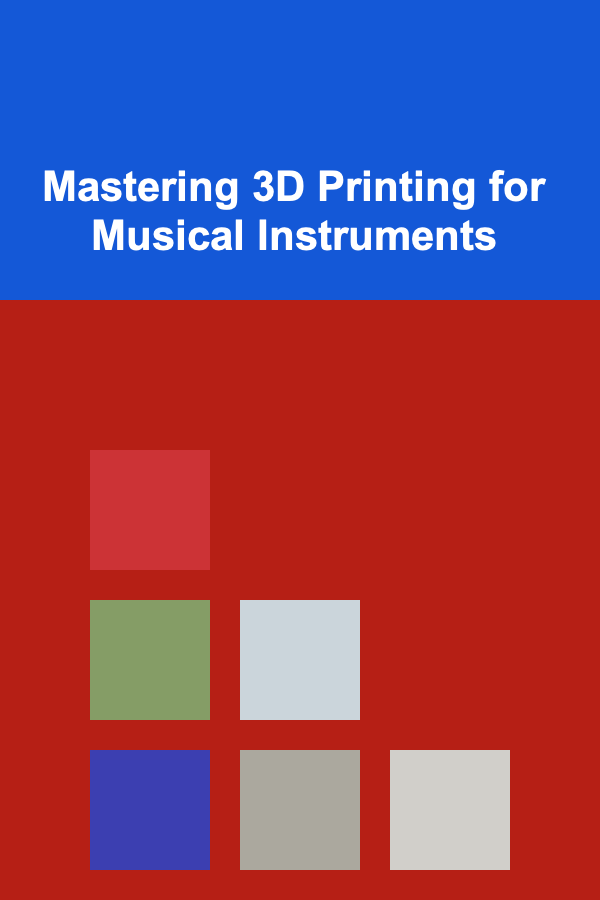
Mastering 3D Printing for Musical Instruments
ebook include PDF & Audio bundle (Micro Guide)
$12.99$7.99
Limited Time Offer! Order within the next:

The intersection of music and technology has always been a fertile ground for innovation. 3D printing, also known as additive manufacturing, has emerged as a revolutionary tool in various fields, and musical instrument design and creation are no exception. This article delves deep into the process of mastering 3D printing for musical instruments, covering aspects from material selection and design considerations to post-processing techniques and acoustic optimization. It is intended for musicians, engineers, designers, and anyone interested in exploring the exciting possibilities of creating musical instruments with 3D printing technology.
The Allure of 3D Printing for Musical Instruments
Traditional instrument making is a craft steeped in history, often requiring years of apprenticeship to master. It relies on subtractive manufacturing -- carving, bending, and assembling pre-existing materials. 3D printing offers a fundamentally different approach:
- Design Freedom: 3D printing allows for the creation of complex geometries and internal structures that are virtually impossible to achieve with traditional methods. This opens up possibilities for new acoustic designs and novel instrument concepts. Think of internal chambers designed to resonate at specific frequencies, or organically shaped bodies that optimize sound projection.
- Customization: Each instrument can be tailored to the individual musician's needs and preferences. From adjusting the size and shape of a mouthpiece to optimizing the finger placement on a fretboard, 3D printing empowers unparalleled customization.
- Rapid Prototyping: The ability to quickly iterate through design changes is invaluable. 3D printing allows musicians and designers to test different prototypes rapidly, allowing for quicker development and optimization of the instrument's sound and playability.
- Material Exploration: A wide range of materials can be used in 3D printing, each with its own unique acoustic properties. This allows for exploration of new tonal qualities and instrument designs. From polymers to metals and even composites, the material options are expanding.
- Cost-Effectiveness (in certain cases): For complex designs or low-volume production, 3D printing can be more cost-effective than traditional manufacturing methods. Tooling costs are significantly reduced, and the waste material is minimized.
However, it's important to acknowledge the limitations. 3D printed instruments often require post-processing to achieve a smooth finish and optimal acoustic performance. The choice of materials can significantly affect the sound quality, and not all materials are suitable for every instrument. Furthermore, the durability of 3D printed instruments needs careful consideration.
Selecting the Right 3D Printing Technology
Several 3D printing technologies are available, each with its own strengths and weaknesses. The choice of technology depends on the desired material, the complexity of the design, the required accuracy, and the budget.
- Fused Deposition Modeling (FDM): This is the most common and affordable 3D printing technology. It works by extruding a thermoplastic filament layer by layer. FDM is suitable for prototyping and creating basic instrument components, but it may not provide the surface finish or accuracy required for high-end instruments. Materials commonly used in FDM include PLA, ABS, PETG, and Nylon. PLA is biodegradable and easy to print, but it is not very durable. ABS is stronger and more heat-resistant, but it is more difficult to print. PETG offers a good balance of strength, ease of printing, and durability. Nylon is a strong and flexible material that is suitable for parts that need to withstand stress.
- Stereolithography (SLA) and Digital Light Processing (DLP): These technologies use a light source to cure liquid resin layer by layer. SLA and DLP produce parts with very high resolution and smooth surfaces, making them suitable for intricate designs and aesthetically pleasing instruments. However, the range of materials is limited, and the parts may be brittle. Resins used in SLA/DLP can be specifically formulated for different properties, such as flexibility or high temperature resistance.
- Selective Laser Sintering (SLS) and Multi Jet Fusion (MJF): These powder-based technologies use a laser or inkjet head to fuse powder particles together. SLS and MJF can produce strong and durable parts with complex geometries. SLS typically uses nylon-based powders, while MJF can use a wider range of materials, including PA12 (Nylon 12), TPU, and polypropylene. These technologies are often used for creating functional prototypes and end-use parts.
- Metal 3D Printing (SLM, DMLS, EBM): These technologies use a laser or electron beam to melt and fuse metal powder. Metal 3D printing is used to create high-strength, high-performance instrument components, such as mouthpieces, bells, and resonators. Materials commonly used in metal 3D printing include aluminum, titanium, stainless steel, and copper. These are significantly more expensive technologies than FDM or SLA.
Choosing the right technology is crucial. For instance, a simple ocarina could be successfully printed using FDM, while a complex trumpet mouthpiece might benefit from the precision and material properties offered by metal 3D printing.
Material Matters: Acoustic Properties and Printability
The material properties of a musical instrument significantly influence its tone, volume, and sustain. When choosing a material for 3D printing a musical instrument, both acoustic properties and printability must be considered.
- Density: Denser materials tend to produce brighter and more resonant tones. Metals, for example, are often used in bells and resonators for this reason.
- Elastic Modulus (Young's Modulus): This measures the stiffness of a material. Stiffer materials tend to vibrate at higher frequencies, producing brighter tones.
- Damping: This measures the material's ability to absorb vibrations. Materials with high damping tend to produce warmer, less resonant tones.
- Printability: This refers to how easily a material can be 3D printed. Some materials are prone to warping, cracking, or other defects.
Here's a closer look at some commonly used 3D printing materials for musical instruments:
- PLA (Polylactic Acid): Easy to print, biodegradable, but less durable and has high damping. Suitable for prototyping and less demanding instruments like ocarinas or whistles. Acoustic qualities are generally considered less desirable than other options.
- ABS (Acrylonitrile Butadiene Styrene): Stronger and more heat-resistant than PLA, but more difficult to print and can warp. Offers slightly improved acoustic properties over PLA, but still not ideal for critical components.
- PETG (Polyethylene Terephthalate Glycol): Offers a good balance of strength, ease of printing, and durability. A good general-purpose material for 3D printed instruments. Offers better resonance than PLA or ABS.
- Nylon: Strong, flexible, and durable. Suitable for parts that need to withstand stress. Offers good acoustic properties and can be used for a variety of instrument components.
- Resins (SLA/DLP): High resolution, smooth surfaces, but can be brittle and limited material options. Resins can be formulated for specific acoustic properties, offering potential for unique tonal qualities.
- Metals (Aluminum, Titanium, Stainless Steel): High strength, durability, and excellent acoustic properties. Suitable for high-end instrument components like mouthpieces, bells, and resonators. Requires specialized and expensive metal 3D printing technology.
- Carbon Fiber Composites: Offer a high strength-to-weight ratio and can be used to create lightweight and resonant instrument components. Often used in conjunction with other materials like nylon.
Experimentation is key. Try different materials and combinations of materials to find the optimal tonal qualities for your instrument design. Consider coating or treating the 3D printed part with varnishes or resins to further enhance its acoustic properties and protect it from moisture.
Designing for 3D Printing: Optimizing for Sound and Manufacturability
Designing a musical instrument for 3D printing requires a different approach than designing for traditional manufacturing. You need to consider the limitations and capabilities of the chosen 3D printing technology, as well as the acoustic principles that govern the instrument's sound.
Key Design Considerations:
- Minimum Feature Size: Each 3D printing technology has a minimum feature size, which is the smallest detail that can be accurately printed. Design features smaller than this limit may be lost or distorted. Consult the specifications of your 3D printer to determine the minimum feature size.
- Wall Thickness: The wall thickness of a 3D printed part affects its strength, stiffness, and acoustic properties. Too thin walls can lead to warping or breakage, while too thick walls can increase the printing time and material cost. Experiment with different wall thicknesses to find the optimal balance between strength and weight.
- Overhangs: Overhangs are portions of the design that are not supported by underlying layers. Excessive overhangs can lead to sagging or deformation. Use supports to provide temporary support for overhangs, but keep in mind that supports need to be removed after printing, which can leave marks on the surface. Minimize overhangs by orienting the part in a way that reduces the need for supports.
- Internal Structures: 3D printing allows for the creation of complex internal structures that can enhance the instrument's strength, stiffness, and acoustic properties. Consider using honeycomb, gyroid, or other infill patterns to create lightweight and strong parts. The density of the infill also affects the sound; denser infill generally leads to a brighter sound.
- Resonance Chambers and Acoustic Optimization: Carefully design the shape and size of resonance chambers to optimize the instrument's tone and volume. Use acoustic simulation software to predict the instrument's sound and make design adjustments accordingly. Consider adding internal features like ribs or baffles to further shape the sound.
- Joints and Assembly: Design the instrument in modular components that can be easily assembled after printing. Use interlocking joints, screws, or adhesives to connect the parts. Consider the tolerances required for a tight and secure fit.
Software and Tools:
- CAD Software (Computer-Aided Design): Essential for creating the 3D model of the instrument. Popular options include Fusion 360, SolidWorks, Blender (for organic shapes), and Tinkercad (for beginners).
- Slicing Software: Converts the 3D model into a set of instructions (G-code) that the 3D printer can understand. Popular options include Cura, Simplify3D, and PrusaSlicer. Slicing software allows you to control parameters such as layer height, print speed, infill density, and support structures.
- Acoustic Simulation Software: Used to predict the instrument's sound and optimize the design. Examples include COMSOL Multiphysics and ANSYS. These are more advanced tools and may require specialized knowledge.
Iterative Design Process: Embrace an iterative design process. Print prototypes, test their sound and playability, and make design adjustments based on the results. This iterative approach is crucial for achieving optimal results.
Post-Processing: Refining the 3D Printed Instrument
3D printed parts often require post-processing to improve their surface finish, accuracy, and acoustic properties. The specific post-processing techniques will depend on the material and the desired result.
- Support Removal: Carefully remove the support structures using pliers, cutters, or other tools. Be careful not to damage the part during support removal.
- Sanding: Use sandpaper to smooth out the surface and remove any imperfections. Start with coarse grit sandpaper and gradually move to finer grits. Wet sanding can help to reduce dust and improve the surface finish.
- Filling: Fill any gaps or imperfections with a filler material, such as epoxy or putty. Sand the filler material smooth after it has dried.
- Priming: Apply a primer to the surface to prepare it for painting. The primer will help the paint adhere to the surface and create a smooth, even finish.
- Painting: Paint the part with the desired color and finish. Use multiple thin coats of paint to avoid runs and drips.
- Polishing: Polish the surface to create a glossy finish. Use a polishing compound and a soft cloth or polishing wheel.
- Coating/Sealing: Applying a coating or sealant can protect the 3D printed part from moisture, UV light, and other environmental factors. It can also improve the instrument's acoustic properties by sealing the surface and reducing damping. Epoxy resins, varnishes, and lacquers are commonly used for this purpose.
- Tuning and Adjustment: Fine-tune the instrument by adjusting the position of the bridge, nut, or other components. Use a tuner to ensure that the instrument is in tune.
Acoustic Post-Processing: Depending on the material and instrument, acoustic post-processing may be necessary. This could involve:
- Vibrational Tuning: Experimentally adjusting the mass distribution of the instrument (e.g., adding small weights) to optimize resonance at specific frequencies.
- Internal Surface Treatment: Applying specialized coatings or textures to the interior of resonance chambers to modify the sound.
- Resonance Amplification: Attaching external resonators or soundboards to amplify the sound.
Examples of 3D Printed Musical Instruments
The possibilities for 3D printed musical instruments are vast and continue to expand. Here are a few examples of instruments that have been successfully 3D printed:
- Ocarinas and Flutes: Relatively simple instruments that can be effectively 3D printed using FDM or SLA.
- Violins and Cellos: More complex instruments that require careful design and material selection. 3D printed violins have been successfully created using both polymer and composite materials. Often, only specific components like the body or neck are 3D printed.
- Guitars and Ukuleles: The bodies of guitars and ukuleles can be 3D printed, allowing for unique designs and internal structures.
- Trumpets and Trombones: Metal 3D printing is ideal for creating brass instruments. 3D printed trumpets and trombones have been shown to have comparable sound quality to traditionally manufactured instruments. Mouthpieces are a particularly popular application.
- Saxophones: While more challenging, 3D printed saxophone components (e.g., the neck and bell) are being explored.
- Experimental Instruments: 3D printing enables the creation of entirely new types of musical instruments with unique sounds and playing techniques. Examples include custom-designed wind instruments with unusual valve systems, or percussion instruments with complex internal geometries.
Many examples can be found online through search engines and platforms like Thingiverse, Instructables, and YouTube. These examples can provide inspiration and guidance for your own 3D printing projects.
Example: 3D Printed Violin (Image for illustrative purposes only)
Challenges and Future Directions
While 3D printing offers significant advantages for musical instrument creation, several challenges remain:
- Material Limitations: The range of materials available for 3D printing is still limited compared to traditional manufacturing. Further research and development are needed to create new materials with enhanced acoustic properties.
- Surface Finish and Accuracy: Achieving a smooth surface finish and high accuracy can be challenging with some 3D printing technologies. Post-processing is often required, which can be time-consuming and labor-intensive.
- Durability: The durability of 3D printed instruments needs careful consideration. Some materials may be prone to cracking or breaking under stress.
- Acoustic Optimization: Optimizing the acoustic properties of 3D printed instruments requires a deep understanding of acoustics and material science. More sophisticated acoustic simulation software and measurement techniques are needed.
However, the future of 3D printed musical instruments is bright. Ongoing research and development are addressing these challenges and opening up new possibilities:
- New Materials: Researchers are developing new materials with enhanced acoustic properties, such as bio-based polymers, composite materials, and smart materials.
- Improved 3D Printing Technologies: Advancements in 3D printing technologies are leading to higher resolution, smoother surfaces, and faster printing speeds.
- Artificial Intelligence (AI): AI is being used to optimize instrument designs and predict their acoustic properties. AI algorithms can also be used to automate the post-processing process.
- Hybrid Manufacturing: Combining 3D printing with traditional manufacturing techniques can leverage the strengths of both approaches. For example, a 3D printed instrument body can be combined with traditionally manufactured hardware and components.
- Democratization of Instrument Design: 3D printing is making it easier for anyone to design and create their own musical instruments, fostering innovation and creativity.
The ability to create personalized, high-performance musical instruments using 3D printing is poised to transform the music industry, offering musicians and instrument makers unprecedented creative freedom and customization opportunities. As the technology evolves and becomes more accessible, we can expect to see a proliferation of innovative and unique 3D printed musical instruments in the years to come.
Resources for Further Learning
- Online Forums and Communities: Join online forums and communities dedicated to 3D printing and musical instrument making. These platforms offer valuable insights, tips, and support from experienced users.
- 3D Printing Workshops and Courses: Consider attending 3D printing workshops and courses to gain hands-on experience and learn from experts.
- Research Papers and Publications: Explore research papers and publications on 3D printing and acoustics to deepen your understanding of the underlying principles.
- Open-Source Designs and Projects: Explore open-source designs and projects for 3D printed musical instruments to gain inspiration and learn from others' work.

How To Get Started with Game Preservation
Read More
How To Play Legacy Games Without Spoilers
Read More
Simple Strategies for Saving on Car Insurance Premiums and Lowering Costs
Read More
Step-by-Step Guide to DIY Household Maintenance and Repairs for Beginners
Read More
Tips for Crafting a Professional LinkedIn Profile for Remote Work
Read More
How To Stay Secure on Public Wi-Fi Networks
Read MoreOther Products

How To Get Started with Game Preservation
Read More
How To Play Legacy Games Without Spoilers
Read More
Simple Strategies for Saving on Car Insurance Premiums and Lowering Costs
Read More
Step-by-Step Guide to DIY Household Maintenance and Repairs for Beginners
Read More
Tips for Crafting a Professional LinkedIn Profile for Remote Work
Read More